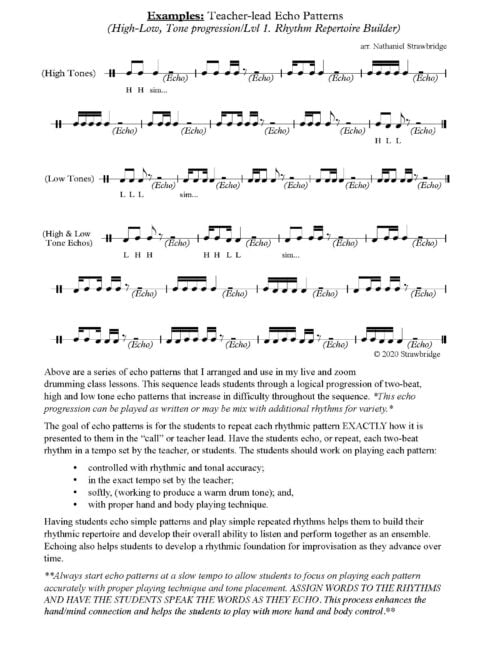“Hello, Ladies and Gentlemen, great to see you? Welcome to our drum class. I hope you are excited… I know that I am. Let’s begin.”
As I uttered this opening statement, I was looking into twenty-two sets of 4th-grade eyes, sitting in twenty-two little boxes, staring back at me, eagerly awaiting the start of our newly created, highly anticipated Zoom drum class. Normally, I would be addressing a class of young musicians in person. Unfortunately, these past few months have been anything but normal.
If you are reading this article, it is more-than-likely that we share a common bond. Just as many of you, I am one of the numerous music educators who has needed to drastically change their approach to teaching due to the recent, yet necessary implementation of online learning. Personally, transitioning my students to online learning (or eLearning), in both my elementary classes and college-level courses has been, to say the least, a growing experience. One filled with challenges, a few frustrations, learning curves, new discoveries, and plenty of rewards.
At the start of my eLearning journey, one thing was clear. I knew that I wanted to “keep the drumming alive” within my students and myself. To that end, I was faced with two essential questions: Why? And How? The “WHY” was apparent. Even though we were learning at a distance, I wanted my students to continue to grow as musicians and have positive music-making experiences. Drumming is a powerful tool, with many uses. In my school, world drumming is not only an integral part of our music curriculum but a significant addition to our overall school community. It offers many benefits to musicians of all ages. My students, young and old, love to drum. I believe drumming is a meaningful pathway to their continued musical growth.
The challenging question then became, “HOW?”
Despite being online…
- HOW can I make world drumming no less effective for my students?
- HOW can I give students a meaningful drumming experience while being devoid of face-to-face teaching and learning?
- HOW, or for that matter, CAN I develop an engaging online drumming experience that builds upon the musical growth my students worked so very hard to obtain throughout the year?
- HOW can WE (meaning the students and I), develop an atmosphere of learning that incorporates the feeling of community and connection; which group drumming so often embodies?
Of course, I found there to be no perfect solution. Whether in the context of drumming, or any area of education, each teacher must personally assess the needs of their students and tackle their “HOWS” in a manner that will best suit their particular students’ needs. However, I can share with you the structure of the online drumming class that I designed for my students. One whose components address each of these daunting, “HOWS.” I will also offer some additional strategies and resources that I believe will be helpful to you in both an online and face-to-face teaching setting.
Table of Contents
Effectively Zooming to A New Beginning
After a month of planning, following our transition into eLearning, my students and I were able to begin our online Zoom-class journey. Let’s take a look at the structure of a typical 4th grade Zoom drum class.
Zoom Drum Class at a Glance: (Activities and Usual Allotted Time)
- Welcome, (2-3 minutes);
- Review of Rules and Expectations, (30 secs – 1 minute);
- Review of Playing Techniques and Tone Production, (1-2 minutes);
- Warm-up and Rhythm Development, (5 minutes);
- Student Choice Activities, (5 minutes);
- Main Lesson Material, (10-12 minutes);
- Content Review and Closing Rumble, (2-3 minutes);
- Final Goodbye! (Time varies depending on the students that day.)
Nurturing the Connection
First and foremost, I began every Zoom drumming session with a welcome. During the quarantine, I truly missed seeing my students on a daily basis and teaching them face-to-face. The students let me know how much they missed each other as well. So, I made an effort to dedicate the first few moments of each session to deliberately greeting the students. During the “welcome,”
- I express my gratitude towards the students for joining the class;
- I let them know that I miss them and how happy I am to see them once again; additionally,
- I allow the students to have a couple of minutes to “unmute” themselves, and greet each other.
I believe the established “welcome routine” gave the students a moment to look forward to each week. Moreover, I believe the “welcome” helped to strengthen our social connection while fostering the feeling of community among us.
Dr. Lisa Flook, a senior researcher at the Learning Policy Institute, speaks to the positive impact the feeling of connection can have on a child within the educational setting. In her article, “Four Ways Schools Can Support the Whole Child,” which synthesizes two comprehensive reviews of the science on children’s development and learning, Dr. Flook writes,
“Brain development is shaped by consistent, supportive relationships; responsive communications; and modeling of productive behaviors. The brain’s capacity develops most fully when children and youth feel emotionally and physically safe; and when they feel connected, engaged, and challenged. Learning is social, emotional, and academic. Positive relationships, including trust in the teacher, and positive emotions, such as interest and excitement, open up the mind to learning.” 1Flook, Lisa. “Four Ways Schools Can Support the Whole Child.” Greater Good, Greater Good Magazine; Science Based Insights for A Meaningful Life, 23 Apr. 2019,
https://greatergood.berkeley.edu/article/item/four_ways_schools_can_support_the_whole_child
In other words, research shows that allowing students the opportunity for positive interaction can help to promote the overall social and emotional health of the “whole child.” Thereby, allowing them to feel connected and safe; ultimately enhancing their overall capacity to learn. Each week, we spend the time to express our feelings towards one another because I wanted my students to feel connected every time they participated in our online drum class.
Engagement and Growth
Following the welcome, the students and I review the Zoom class rules and expectations, (see Instructional Tips #2 & #3); engage in a quick review of proper drumming techniques and tone production, (see Instructional Tip #4 and Instructional Resources, pages. 7-17), and warm-up our “rhythmic motors” by playing high and low tone variations on the steady beat and echo playing multi-beat rhythmic patterns that progressively increase in difficulty, (see Instructional Tip #5 and Instructional Resources, Pg. 5, for “Notation of Echo Progression”).
After the warm-up and review, we get busy! I jump onto the keyboard and lead the students through a variety of simple and intermediate drum ostinatos, that transition from one-to-the-next without stopping. We then move to a fast-paced series in which, in consecutive order, the students perform four high-tones, four low-tones, four open-palm taps on the sides of the drum, (which the students adapt to fit their chosen instruments at home), and four over-head claps, all to the steady beat. We creatively call this repeating series, “The Sequence.” Watching the students perform our “sequence” is one of my favorite moments of the class. As I jump from the keyboard to the shekere, to the drum, I look up to see hands flying, bodies moving, pizza boxes and buckets shaking, and most of all smiles on the students’ faces. That one picturesque moment is motivation enough for us to “keep the drumming alive!”
Meaningful Drumming
Following our sequence, I give the students an opportunity to choose our next musical activities. In my experience, students often chose to…
- review rhythms they enjoyed from previously learned drum pieces;
- take turns leading the class using their created series of echo rhythm patterns; and/or
- perform improvised solos for the class.
The allotted time for student choice is an important component of the class, because it allows students the opportunity to take ownership of their class content, thereby creating motivation, value, and meaning. An extensive study has examined the value of student choice.
Mike Anderson, author of, “Learning to Choose, Choosing to Learn” The Key to Student Motivation and Achievement”, writes,
“Through choice, you can help students self-differentiate their learning, so work is more appropriately challenging. You can also combat student apathy, helping students connect with their strengths and interests and giving them more autonomy, power, and control over their work, which boosts their intrinsic motivation.”2Anderson, Mike. “Chapter 1. The Key Benefits of Choice.” The Key Benefits of Choice, ASCD, 2016, www.ascd.org/publications/books/116015/chapters/The-Key-Benefits-of-Choice.aspx.
http://www.ascd.org/publications/books/116015/chapters/The-Key-Benefits-of-Choice.aspx
Additionally,
“maintaining a focus on student choice helps to create learning environments of meaning where student voices matter.”3Block, Joshua. “Student Choice Leads to Student Voice.” Edutopia, George Lucas Educational Foundation, 30 Oct. 2014, https://www.edutopia.org/blog/student-choice-leads-to-voice-joshua-block
I have even noticed, during our online classes, some of the quieter students who are typically reluctant and cautious in a live learning setting, become more courageous by stepping out of their comfort zone and engaging through sharing and even leading.
The Core of the Lesson
We spend the last ten-twelve minutes of the class diving into our main lesson material. Since our drumming lessons mainly focus on the study of music from different cultures around the world, we learn to play rhythms from traditional West African-styled pieces such as, “Akom Advanced,” and “Sinte.” (See Instructional Resources, for “Sinte Notation.”) We progressively learn every rhythm from each piece and dive into discussions related to the culture and historical background of the pieces. Finally, as our class’ rhythmic proficiency improves, the students and I apply those rhythms to a performance context. (See Instructional Tip #6.)
Additionally, I use the last instructional moments of the class to share supplementary links and resources with the kids. Ones that can help them to practice between class sessions, as well as guide their continued musical growth over the summer. We engage in a final review of the day’s content and end with one last furious drum roll and thunderous cut-off! Lastly, we say our goodbyes. Although bittersweet, the “goodbye” was another moment that I came to enjoy. Once again, I was able to watch the students talk with each other, laugh, wave, and express their care for one another. As I expressed earlier, the kids missed each other, and I missed them. In my opinion, this powerful moment was further evidence that the experience of music-making was keeping the students connected. To that end, and I think you will agree, music connects us all.
Final Thoughts
I believe I speak for most when I say, the 2019-2020 school year did not end the way any of us would have ever imagined. If that were not enough, we have yet to know how different the 2020-2021 school year will look. Being away from live teaching, however, has reminded me of one thing… I truly LOVE teaching music. Whether teaching online or face-to-face, we must continue to work to help our future musicians grow into the artists that we know and believe them to be. Our students’ musical growth should not be halted simply because we are not physically standing in front of them in our classrooms. We must continue to discover, and dare I say create, new and accessible, all-inclusive methods of delivering the high-quality instruction that our students so desperately need, crave, and deserve.
To create the best learning environment for our students, each teacher must address the “How’s” of your classroom in your own unique way. Find YOUR strengths and apply them to fulfill the needs of your students, to enhance THEIR strengths. Drumming is my passion and the passion of so many of my students. Therefore, we choose to keep the drumming alive. Whatever YOU and YOUR students’“drumming” may be — for the sake of us ALL — I urge you to please,
Keep The Music Alive!
Want a copy of Nathaniel’s materials for this post? Check out his eBook, Keep the Drumming Alive!






Leave A Comment